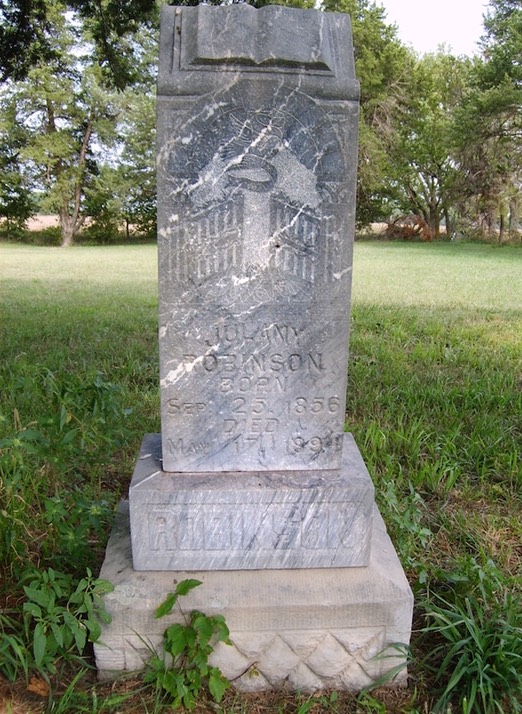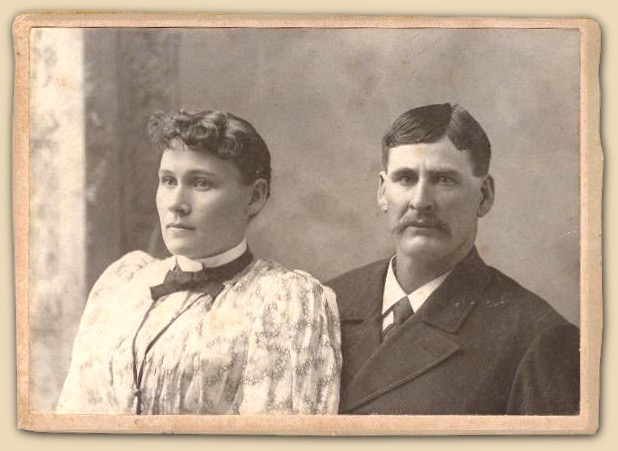The headstone in White Rock Cemetery for Thomas Lovewell’s daughter Julia reads:
Julany Robinson Born Sep. 25, 1856 Died May 17, 1894

In 1871 she had married an Irish lad named Edward McCaul, a bridge carpenter who drew his last breath at the Missouri Pacific Railroad Hospital in St. Louis in 1894. The end came only a few weeks before his widow died of cancer at the village of Lovewell. And yet, it was another man, John Robinson, who provided the surname chiseled on Julia's grave marker. What do we know about him?
We know more than we did a year ago, thanks in part to Rhoda Lovewell’s forthcoming update of family lore, “The Lovewell Family Revisited.” Besides going to the trouble of touring county seats to collect wills and land records in regions where her ancestors had once lived, Rhoda conducted interviews with many of the descendants of Thomas Lovewell, collecting along the way another rare nugget of information about Thomas's son-in-law, the elusive John Robinson: His middle initial was “W,” which stood for “William.”
Some of what I’ve learned about him in recent years belongs in the minus column - knowing who he isn't. I know, for instance, that the one figure in a photograph usually identified as him is another John Robinson entirely, Thomas Lovewell’s nephew. While we’re at it, the woman seated beside the mustached man in the photo, often identified as Thomas Lovewell's daughter "Julany," is in fact his niece, Rhoda Robinson, John’s sister. The siblings had been living apart since the death of their father in Illinois in 1878, and the portrait, taken in Superior, Nebraska, is probably a memento of one of their reunions.

Until now we’ve been fairly certain of spotting Mr. Robinson in only two historical documents, the 1885 Kansas census, taken when he was living with Julia (Lovewell) McCaul in Carbondale, Kansas, and the one recorded ten years later in Lovewell, Kansas, a year after Julia’s death.
In the 1885 census John Robinson is listed as a 38-year-old native-born Kansan, making a living just then by laboring in one of the coal mines at Carbondale. In the 1895 census document, perhaps the only one for which he supplied the personal information, he calculates his age as 46, his profession as “engineer” and his place of birth as Delaware. Except for the fact that in both instances he shares a home with children named Willie and Alice (along with assorted others), there are enough key differences between details listed in the two documents, that we might suppose them to be records of two individuals named John Robinson, the first, a miner born in Kansas in 1847, and the other an engineer born in Delaware in 1849.
It hasn’t been easy to pin down a man with one of the most common names in 19th century America. However, armed with Robinson’s middle initial, I took a second look at some of the other candidates from the 1880 census. He had to be hiding somewhere, for despite the fact that in 1879 John Robinson took out a license to marry Julia McCaul’s stepsister, 17-year-old Susan Turnbull, nine months after her wedding the census-taker found Susie “Roberinson” still living with her parents in Carbondale. What had become of her new husband?
He may have been working in North Platte, Nebraska, where a 31-year-old railroad engineer named John W. Robinson checked into a boarding house with his older brother James, a conductor. Given the fact that they share the same name, the same estimated birth year (1849) and the same profession, the only real objection to identifying this John Robinson as the same man who would one day be a widower at Lovewell, is the fact that the Robinson brothers, when cornered by the census-taker at North Platte, claimed to have been born in Pennsylvania. It may be worth noting that one of the most populous counties in Pennsylvania is Delaware County, just west of Philadelphia and adjacent to New Castle County, Delaware. Perhaps James had indeed been born across the border in Pennsylvania, and was the one who fed information to the census official in 1880.
If Susan’s husband was working in Nebraska in the earlier 1880’s, she may have joined him there. This scenario would explain why, in the 1895 Kansas census, their two teenage girls listed Nebraska as their place of birth.
It’s doubtful that we’ll ever understand the drama that played out in Carbondale, the events and emotions that split up the Robinson and McCaul marriages and drove Julia McCaul into John Robinson’s arms. However, little pieces have started dropping into place, thanks to Rhoda Lovewell's interviews and the addition of a simple “W” to John Robinson’s name.